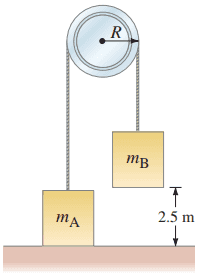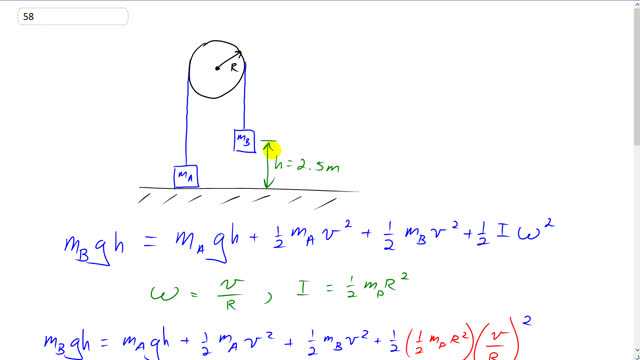
Two masses, and , are connected by a rope that hangs over a pulley (as in Fig. 8–54). The pulley is a uniform cylinder of radius and mass 3.1 kg. Initially is on the ground and rests 2.5 m above the ground. If the system is released, use conservation of energy to determine the speed of just before it strikes the ground. Assume the pulley bearing is frictionless.


In order to watch this solution you need to have a subscription.
This is Giancoli Answers with Mr. Dychko. The total energy of the system before it's released is entirely gravitational potential energy; there's no kinetic energy because it starts at rest. So the only gravitational potential energy that we are concerned with is this mass B above the ground which we'll take to be our reference level so that there's no gravitational potential energy for mass A. And so all of our energy initially is just mass B times g times its height above the ground. And then just before mass B contacts the ground, after the system is released, we have everything in motion. m A is moving upwards, this pulley is rotating and mass B is moving downwards and so there's three kinetic energy terms: mass A moving upwards with kinetic energy, mass B moving downwards with translational kinetic energy, and then this pulley having rotational kinetic energy. And also some of the energy in the final case is accounted for as gravitational potential energy of mass A as it rises up upwards. So all the gravitational and the potential energy the mass B has initially gets turned into gravitational potential for mass A and then three kinetic energy terms. So let's do some substitutions and solve for v. Notice I didn't put a subscript on the v here I could have written v A and v B here but I didn't because mass A and mass B will have the same speeds... velocity the fact that they are going in opposite direction doesn't matter here we'll take this to be the positive direction: upwards on the left and downwards on the right and furthermore since the thing is squared anyway, the negative signs don't matter so it's just speed we are concerned with there and they are the same speeds because the masses are connected by this string and the speed with which mass B moves down will be the same speed with which mass A moves upwards. So no need for subscripts there v is ultimately what we are trying to find in this question and ω can be written in terms of v by writing it as v over R because points on the edge of this pulley will have a translational speed equal to the speed at which this rope is going and which in turn is this speed at which these masses are going. because there's no slipping happening here so the speed at which this rope passes over the pulley is the same as the speed at which points on the rim of the pulley are moving. And so the angular speed of the pulley, ω, equals the speed on the rim divided by the distance to the rim, the radius, in other words. And then the moment of inertia for a cylinder or a disk is one-half times mass of the pulley times its radius squared. So we'll substitute for each of those things: I and ω here, rewriting it otherwise so I have written one-half mass pulley radius squared and then the speed of the point on the rim divided by the pulley radius and then that will all get squared and that's the substitution for ω here. Then fraction's are annoying so let's get rid of them by multiplying everything by 4. So we have 4m Bgh equals 4m Agh plus 2m Av squared plus 2m Bv squared plus m Pv squared this one-half plus one-half makes one quarter times 4 makes just 1 and then the r squared's cancel there too and there we go. And then the next step is to collect all the v squared terms on one side of the equation alone and we have v squared factored out times 2 times m A plus 2 m B plus m P and then take this term to the left side, it becomes a minus and then switching the sides around as well and so we have the 4gh is a common factor between these two terms so we have 4gh times m B minus m A and then divide both sides by this thing, take the square root of both sides and you have... well this 2 comes from the fact that square root of 4 is 2 so I took that out of the square root sign and so we have v is 2 times square root gh times m B minus m A divided by 2 times m A plus 2 times m B plus just the regular mass of the pulley there. Okay! So in the calculator it looks like this: we have 2 times square root 9.8 times 2.5 meters times 38 kilograms minus 32 kilograms— I don't know why I wrote meters in there— (and you get the idea) and then all gets divided by 2 times 32 kilograms plus 2 times 38 kilograms plus 3.1 kilograms which is 2.0 meters per second will be the speed that mass B hits the ground with.
why did you multiply it by 4?
Hi aquaoasis14, thanks for the question. At the 2:00 minute mark in the video, I multiply by 4 since 4 is the lowest common denominator of the fractions in the equation. Doing this gets rid of the fractions since, as a matter of personal opinion, they're annoying! It would be possible to solve the equation just fine while keeping the fractions, if you prefer. The last term in the equation has 1/2 multiplied by 1/2 (making 1/4), keep in mind, so that's why I needed to multiply by 4 instead of 2.
Hope that helps,
Mr. Dychko
The gravitational potential energy of mass A and mass B, how come we can use the same H value in this problem?
Figured it out.